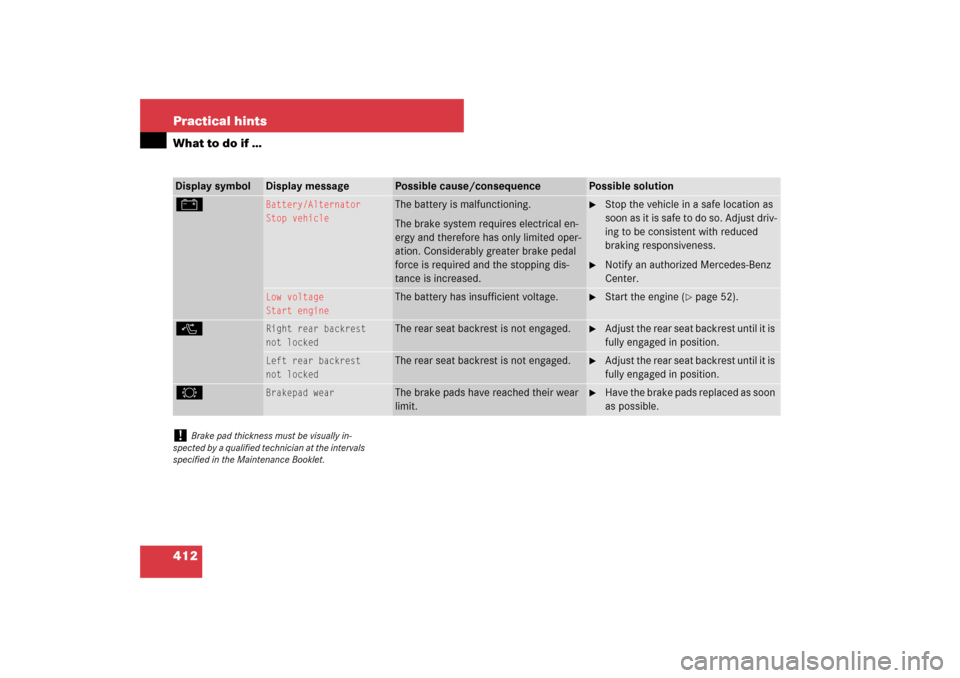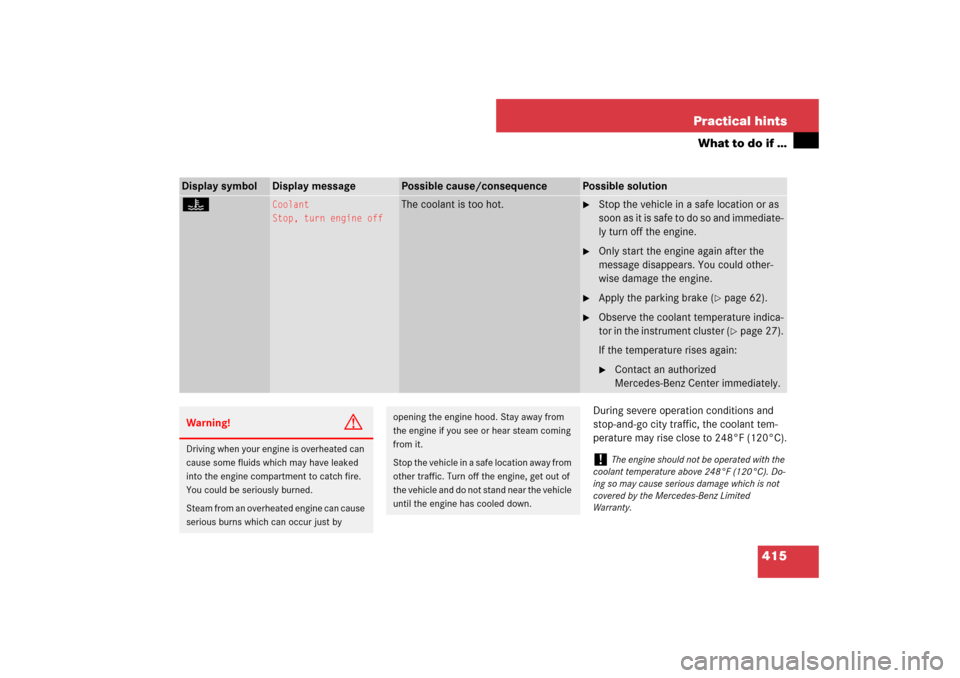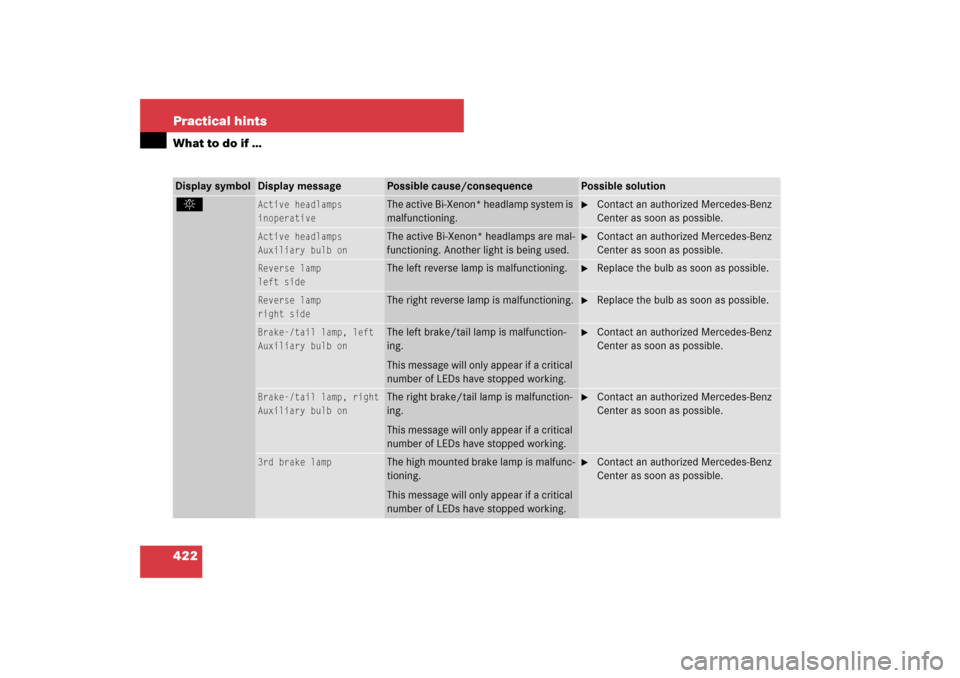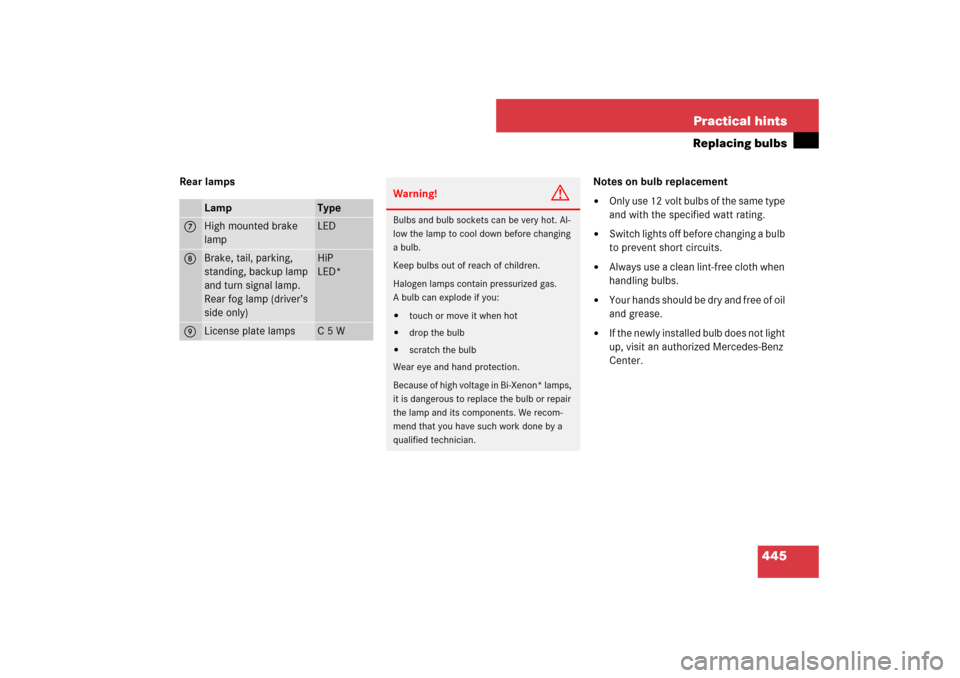Page 413 of 522

412 Practical hintsWhat to do if …Display symbol
Display message
Possible cause/consequence
Possible solution
#
Battery/Alternator
Stop vehicle
The battery is malfunctioning.
The brake system requires electrical en-
ergy and therefore has only limited oper-
ation. Considerably greater brake pedal
force is required and the stopping dis-
tance is increased.
�
Stop the vehicle in a safe location as
soon as it is safe to do so. Adjust driv-
ing to be consistent with reduced
braking responsiveness.
�
Notify an authorized Mercedes-Benz
Center.
Low voltage
Start engine
The battery has insufficient voltage.
�
Start the engine (
�page 52).
(
Right rear backrest
not locked
The rear seat backrest is not engaged.
�
Adjust the rear seat backrest until it is
fully engaged in position.
Left rear backrest
not locked
The rear seat backrest is not engaged.
�
Adjust the rear seat backrest until it is
fully engaged in position.
2
Brakepad wear
The brake pads have reached their wear
limit.
�
Have the brake pads replaced as soon
as possible.
!
Brake pad thickness must be visually in-
spected by a qualified technician at the intervals
specified in the Maintenance Booklet.
Page 414 of 522

413 Practical hints
What to do if …
Display symbol
Display message
Possible cause/consequence
Possible solution
(USA only);(Canada only)3
EBV, ABS, ESP
inoperative
See Operator’s Man.
ABS, ESP
®, EBP as well as PRE-SAFE
®
have switched off due to a malfunction.
BAS is also switched off.
The brake system is still functioning nor-
mally but without the ABS, BAS, ESP
® and
PRE-SAFE
® available.
�
Continue driving with added caution.
�
Adjust driving to be consistent with
reduced braking responsiveness.
�
Visit an authorized Mercedes-Benz
Center as soon as possible.
Release parking
brake
You are driving with the parking brake
set.
�
Release the parking brake
(�page 55).
Check
brake fluid level
There is insufficient brake fluid in the
reservoir.
�
Risk of accident! Stop the vehicle in a
safe location as soon as it is safe to do
so and notify an authorized
Mercedes-Benz Center. Do not add
brake fluid! This will not solve the
problem.
Warning!
G
Driving with the message
Check brake
fluid level
displayed can result in an ac-
cident. Have your brake system checked im-
mediately.
Do not add brake fluid before checking the
brake system. Overfilling the brake fluid res-
ervoir can result in spilling brake fluid on hot
engine parts and the brake fluid catching
fire. You can be seriously burned.
!
If you find that the brake fluid in the brake
fluid reservoir has fallen to the minimum mark or
below, have the brake system checked for brake
pad thickness and leaks.
Page 416 of 522

415 Practical hints
What to do if …
During severe operation conditions and
stop-and-go city traffic, the coolant tem-
perature may rise close to 248°F (120°C).
Display symbol
Display message
Possible cause/consequence
Possible solution
•
Coolant
Stop, turn engine off
The coolant is too hot.
�
Stop the vehicle in a safe location or as
soon as it is safe to do so and immediate-
ly turn off the engine.
�
Only start the engine again after the
message disappears. You could other-
wise damage the engine.
�
Apply the parking brake (
�page 62).
�
Observe the coolant temperature indica-
tor in the instrument cluster (
�page 27).
If the temperature rises again:
�
Contact an authorized
Mercedes-Benz Center immediately.
Warning!
G
Driving when your engine is overheated can
cause some fluids which may have leaked
into the engine compartment to catch fire.
You could be seriously burned.
Steam from an overheated engine can cause
serious burns which can occur just by
opening the engine hood. Stay away from
the engine if you see or hear steam coming
from it.
Stop the vehicle in a safe location away from
other traffic. Turn off the engine, get out of
the vehicle and do not stand near the vehicle
until the engine has cooled down.
!
The engine should not be operated with the
coolant temperature above 248°F (120°C). Do-
ing so may cause serious damage which is not
covered by the Mercedes-Benz Limited
Warranty.
Page 423 of 522

422 Practical hintsWhat to do if …Display symbol
Display message
Possible cause/consequence
Possible solution
.
Active headlamps
inoperative
The active Bi-Xenon* headlamp system is
malfunctioning.
�
Contact an authorized Mercedes-Benz
Center as soon as possible.
Active headlamps
Auxiliary bulb on
The active Bi-Xenon* headlamps are mal-
functioning. Another light is being used.
�
Contact an authorized Mercedes-Benz
Center as soon as possible.
Reverse lamp
left side
The left reverse lamp is malfunctioning.
�
Replace the bulb as soon as possible.
Reverse lamp
right side
The right reverse lamp is malfunctioning.
�
Replace the bulb as soon as possible.
Brake-/tail lamp, left
Auxiliary bulb on
The left brake/tail lamp is malfunction-
ing.
This message will only appear if a critical
number of LEDs have stopped working.
�
Contact an authorized Mercedes-Benz
Center as soon as possible.
Brake-/tail lamp, right
Auxiliary bulb on
The right brake/tail lamp is malfunction-
ing.
This message will only appear if a critical
number of LEDs have stopped working.
�
Contact an authorized Mercedes-Benz
Center as soon as possible.
3rd brake lamp
The high mounted brake lamp is malfunc-
tioning.
This message will only appear if a critical
number of LEDs have stopped working.
�
Contact an authorized Mercedes-Benz
Center as soon as possible.
Page 428 of 522
427 Practical hints
What to do if …
Display symbol
Display message
Possible cause/consequence
Possible solution
H
Please correct
tire pressure
The pressure is too low in one or
more tires.
�
Check and correct tire inflation pressure as
required (
�page 342).
Tire pressure
Caution, tire defect
One or more tires are deflating.
�
Carefully bring the vehicle to a halt, avoiding
abrupt steering and braking maneuvers.
�
If necessary, change the wheel (
�page 452).
Tire pressure
Check tires
One or more tires are deflating.
The respective tire is indicated in
the multifunction display.
�
Carefully bring the vehicle to a halt, avoiding
abrupt steering and braking maneuvers.
�
If necessary, change the wheel (
�page 452).
Warning!
G
Do not drive with a flat tire. A flat tire affects
the ability to steer or brake the vehicle.
You may lose control of the vehicle. Contin-
ued driving with a flat tire will cause exces-
sive heat build-up and possibly a fire.
Page 429 of 522
428 Practical hintsWhat to do if …Display symbol
Display message
Possible cause/consequence
Possible solution
H
Tire pressure
Check tires
The tire pressure in one or more
tires is already below the mini-
mum value.
�
Carefully bring the vehicle to a halt, avoiding
abrupt steering and braking maneuvers.
�
Check and adjust tire pressure as required.
�
If necessary, change the wheel (
�page 452).
Check tires
The tire pressure in one or more
tires is already below the mini-
mum value.
The respective tire is indicated in
the multifunction display.
�
Carefully bring the vehicle to a halt, avoiding
abrupt steering and braking maneuvers.
�
Check and adjust tire pressure as required.
�
If necessary, change the wheel (
�page 452).
Warning!
G
Do not drive with a flat tire. A flat tire affects
the ability to steer or brake the vehicle.
You may lose control of the vehicle. Contin-
ued driving with a flat tire will cause exces-
sive heat build-up and possibly a fire.
Page 435 of 522

434 Practical hintsWhere will I find ...?Vehicle tool kit
The vehicle tool kit is stored in the com-
partment underneath the trunk floor
(�page 432).
The vehicle tool kit includes:
�
One pair of universal pliers
�
One towing eye bolt
�
One wheel wrench
�
One alignment bolt
�
One fuse extractor
�
Spare fuses
�
Collapsible wheel chock
�
A pair of gloves
Setting up the collapsible wheel chock
The collapsible wheel chock serves to
additionally secure the vehicle, e.g. while
changing the wheel.1Tilt the plates upward
2Fold the lower plate outward
3Insert the plate
�
Tilt both plates upward1.
�
Fold the lower plate outward2.
�
Guide the tabs of the lower plate all the
way into the openings of the base
plate3.
Vehicle jackWarning!
G
The jack is designed exclusively for jacking
up the vehicle at the jack take-up brackets
built into both sides of the vehicle. To help
avoid personal injury, use the jack only to lift
the vehicle during a wheel change. Never
get beneath the vehicle while it is supported
by the jack. Keep hands and feet away from
the area under the lifted vehicle. Always
firmly set parking brake and block wheels
before raising vehicle with jack.
Do not disengage parking brake while the
vehicle is raised. Be certain that the jack is
always vertical (plumb line) when in use,
especially on hills. Always try to use the jack
on level surface. Make sure the jack arm is
fully seated in the jack take-up bracket.
Always lower the vehicle onto sufficient
capacity jackstands before working under
the vehicle.
Page 446 of 522

445 Practical hints
Replacing bulbs
Rear lamps Notes on bulb replacement
�
Only use 12 volt bulbs of the same type
and with the specified watt rating.
�
Switch lights off before changing a bulb
to prevent short circuits.
�
Always use a clean lint-free cloth when
handling bulbs.
�
Your hands should be dry and free of oil
and grease.
�
If the newly installed bulb does not light
up, visit an authorized Mercedes-Benz
Center.
Lamp
Type
7
High mounted brake
lamp
LED
8
Brake, tail, parking,
standing, backup lamp
and turn signal lamp.
Rear fog lamp (driver’s
side only)
HiP
LED*
9
License plate lamps
C5W
Warning!
G
Bulbs and bulb sockets can be very hot. Al-
low the lamp to cool down before changing
a bulb.
Keep bulbs out of reach of children.
Halogen lamps contain pressurized gas.
A bulb can explode if you:�
touch or move it when hot
�
drop the bulb
�
scratch the bulb
Wear eye and hand protection.
Because of high voltage in Bi-Xenon* lamps,
it is dangerous to replace the bulb or repair
the lamp and its components. We recom-
mend that you have such work done by a
qualified technician.